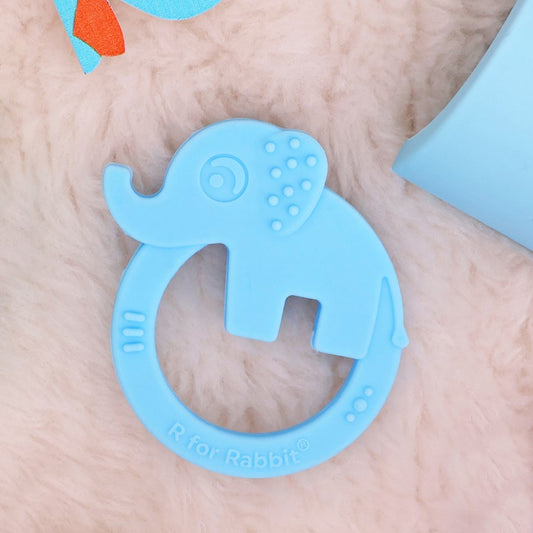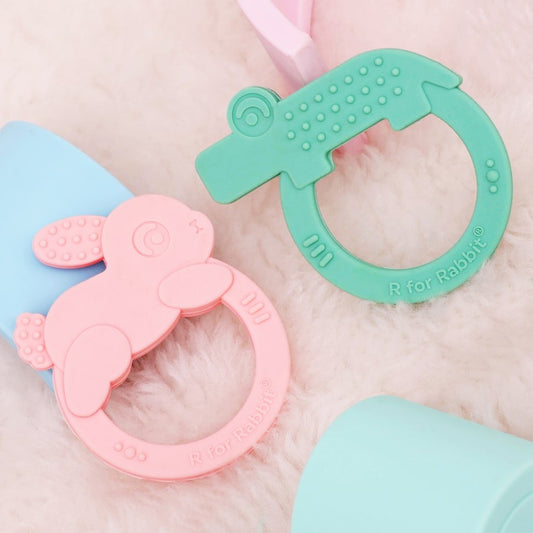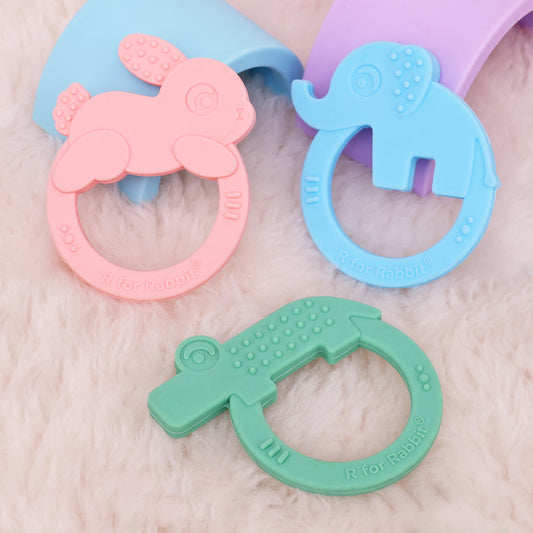How To Choose the Right Teether To Match Your Baby's Age

Teething is better known as the stage in which a baby’s primary teeth begin to grow, and this normally ranges from 6 months to 2 to 3 years. At this age, babies are slightly uncomfortable as teeth start to show through the gums as first teeth emerge.
One of the crucial decisions you need to make when your children are at this age involves choosing the right teether that will not end up harming them. A teething ring is useful to ease pain and accomplish the tasks of teething, as well as develop senses and prevent cavities.
In this baby teether buying guide, we shall be outlining some factors to consider when choosing age-appropriate teethers, the various categories of teethers, and some other significant features to comprehend.
Understanding Teething Stages
To choose the right teether for your baby, you first need to understand his or her teething phases.
A. Early Teething (0 - 3 Months)
During the initial period of teething, infants may begin showing signs of teething before they develop their first teeth. This stage is accompanied by a child’s drooling, chewing on hands, and occasional bouts of fussiness. As they are still in the developmental stage, hand-eye coordination and motor skill development are not fully developed; hence, soft teethers and light with easy grip are ideal.
B. Active Teething (4 - 7 Months)
At 4-7 months, teething starts getting aggressive as the first set of teeth starts to show. Babies in this developmental category may be crankier and require teethers that offer comfort from various textures and have a cool touch. They are also learning how to grasp objects, so teethers should be shaped to easily fit in small children’s hands.
C. Late Teething (8 - 12 Months)
By the time they are about 8-12 months, babies have several teeth and are regressing on their molars. They may be more inclined towards teethers with a range of textures and harder surfaces to chew on as well. Tooth toys that can be chewed heavily and that can also offer relief at the back teeth would be age-appropriate teethers.
Teether Types for Different Ages
A. Newborns 0 to 3 Months
Teethers for newborns and very young infants must be soft and gentle to avoid causing harm to the babies. Here are some options:
- Soft, Lightweight Teethers
These teethers are made of silicone or soft rubber, so the baby finds it easier to hold and chew on. They are normally polished and have no sharp corners or surfaces on them.
- Teething Mittens
These are mittens that can be worn on hands with rough surfaces that are suitable for chewing on by the child. They are especially helpful for babies who still cannot grip common teethers due to a lack of advanced motor functions.
B. 4 to 7 Months
As babies grow and their teething needs evolve, consider these types:
- Textured Silicone Teethers
These offer different surfaces that can gently rub and help to relieve sore gums. The different textures assist in the development of the senses and also give some sort of comfort.
- Cooling Teethers
These teethers are made by filling them with a safe gel or liquid, and freezing them in the refrigerator to offer a cooling effect that can help in the reduction of inflammation of gums. Make sure there are no toxic substances added to them and that the contents inside are tightly closed.
C. 8 to 12 Months
At this stage, teethers should accommodate more intense chewing:
- Harder Teethers for Back Teeth
Some manufacturers use very rigid materials like hard silicone or wood to construct teethers, which can be useful when handling the discomfort occasioned by molars emerging. They should be hardy enough to endure rigorous churning within the mouth cavity.
- Teething Toys with Multiple Textures
This type of toy can include toys of various textures and features to help older babies occupy themselves and offer the needed relief for various stages of teething.
11 Key Factors to Consider for Baby Teething
1. Safety (BPA-Free, Phthalate-Free)
After you choose the type of teether, you have to consider the safety of the teether in issue. The teether that you have chosen should be free of phthalates and BPA since those are unsafe for your children.
Some teethers can be very dangerous to your infant's health, and because of that, you should make your child use teethers that will be manufactured from such material, which certifying agencies recommend as safe.
2. Easy to Clean and Sterilize
Since the teething toys go into the baby's mouth, it is good to go for those that are easy to clean and keep the germs and other pathogens at bay.
Ensure your kid does not use anything contaminated with bacteria by checking whether the teethers can be washed-up in the dishwasher or with some hot water and soap.
One such remarkable substance used is silicone, which often requires just wiping and does not stick, nor does it require much cleaning.
3. Size and Weight that the Baby Can Hold
There is also a need to make sure that the teethers are of a size that the baby can hold in the hand while sucking. They should neither be grossly oversized nor very heavy so that the baby will be able to manage and use them appropriately.
Select teethers that come in bright colours and are not large but shaped in a way to fit into the baby’s hands.
4. Durability and Longevity
Teething is quite a tasking process and most infants are inclined to bite more when they are teething. It is recommended that parents should be careful when choosing teethers to choose those that are strong and would not easily wear out especially when in frequent use.
High-quality silicone rubber and wooden material should be stronger and more durable, thus resulting in a longer lifespan.
Material Choices for Teethers
5. Silicone
Silicone teethers are gentle on baby’s gums. These teethers are harmless and do not contain toxic compounds. Silicone teethers are also sturdy and can be used when the baby cannot control his jaws and has begun biting. They are soft, flexible, and easy to clean.
6. Rubber
Natural rubber teethers are another great choice. They are soft and easy to bend meaning they offer sufficient resistance to aid the process of chewing among babies. Make sure that no synthetic additives and chemicals have been used when the rubber is being manufactured.
7. Wood
Washable wooden teethers are safer and more environmentally friendly. They are tough and can be shaped and used in various forms and surfaces. However, make sure the wood is raw and sealed or painted with layers that are safe for babies.
8. Plastic
There are many types of teethers, and you can buy plastic teethers for a low price. Make sure the one you pick is made of good quality BPA-free plastic meant for babies. Check that the materials used do not have any small pieces that could cause choking.
Special Teether Types
9. Vibrating Teethers
Battery-operated teethers are common, and they vibrate gently and can be useful for soothing sore gums. Some of these teethers possess another component that can be useful when the baby is cranky.
When selecting a vibrating teether, use one that does not have any potentially hazardous parts and is easy to clean.
10. Musical Teethers
Musical teethers are designed in such a way that they appeal to all the senses of your baby. It is useful because the music can help to alleviate and soothe the baby during teething.
Make sure that the sound feature is not too loud so that it becomes harsh and uncomfortable for the users.
11. Natural Teethers
Beaded necklaces made of amber are believed to possess the capability of easing teething due to their anti-inflammatory nature.
However, these should be used carefully and, if possible, under supervision, as they can cause choking or strangulation hazards. Before they are used, it is always advisable to check with a paediatrician.

Key Takeaways
Selecting a teether is determined by the development state of the baby and other factors to consider for baby teether. This way, thinking about the different teething stages, teether types, and key features, one can choose the teether that will be comfortable, safe, and entertaining for the baby.
Studying your baby’s preferences and making sure that the teether you have chosen meets all the safety and functionality requirements will help to simplify the process of teething for both the baby and the parent.
To find a variety of different teethers that are colourful and safe for children of different ages, you may want to check out Teether products on R for Rabbit website.
We focus on the safety of our products while at the same time ensuring that the comfort of the child is not compromised, and they have taken the necessary steps to ensure that they cover all the stages of the teething period as they know that it is a very sensitive stage for a child. Choose a good teether today to help your child have a smooth teething process without much stress.











